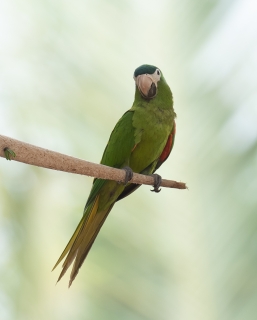Red-shouldered Macaw |
|
|
Also known as: Hahn's Macaw, Noble Macaw (D.n. cumanensis)
Photos
View in GalleryDid You Know?
At 165g (5.8 oz) the Red-shouldered Macaw is the smallest of all the macaws. By contrast, the Hyacinth Macaw is 1400g (49 oz) or more.Academic Research
Related publications: Diopsittaca nobilisSpecies Profile
Genus: Diopsittaca | Species: nobilis
Size:
30cm (11.7 in)
Weight:
130-170g (4.5-6 oz)
Subspecies including nominate:
three: D.n. nobilis, D.n. cumanensis, D.n. longipennis
Colour Adult:
D.n. nobilis: Both adults in general yellow/green; blue forehead and forecrown; red bend of wing, carpal edge and lesser underwing coverts. Bill dark grey. Face bare and white. Eye dark orange.
D.n. cumanensis: Both adults larger than nobilis, larger bill with horn coloured upper mandible.
D.n. longipennis: Both adults as in cumanensis, but larger in size.
Colour Juvenile:
D.n. nobilis: Green forehead and forecrown; green bend of wing and carpal edge, replacing red; lesser underwing coverts red. Eye brown.
Call:
Calls made in flight are shrill and repetitious, emitted in short bursts; or harsh notes. Calls of an entire flock produce a vibrating tone.
Listen NowVideo Links:
Video 1 | Video 2More Information:
Content Sources:
CITES
BirdLife International
Cornell Lab of Ornithology/Birds of the World
Parrots: A Guide to Parrots of the World, Juniper and Parr, 1998
ML Media Collection Catalogue 128077, Red-shouldered Macaw Diopsittaca nobilis, Marantz, Curtis, Sergipe, Brazil, Mar. 12 2001, Cornell Lab of Ornithology. Site
Parrots of the World, Forshaw and Cooper, 1977. 2010 edition
Parrots of the World, Forshaw, 2006.
Parrots in Aviculture, Low, 1992.
Psittacine Aviculture, Schubot, Clubb and Clubb, 1992.
Photos
View in GalleryDid You Know?
At 165g (5.8 oz) the Red-shouldered Macaw is the smallest of all the macaws. By contrast, the Hyacinth Macaw is 1400g (49 oz) or more.Academic Research
Related publications: Diopsittaca nobilisSpecies Care
Captive Status:
Fairly common
Longevity:
25-40 yrs
Housing:
Birds kept in smaller cages should have access to large enclosure for part of the year, at least 15m (49 ft) long. Keeping permanently indoors not recommended.
Diet:
Soaked or sprouted sunflower seed; walnuts (must be cracked), peanuts, pecans, Brazil nuts (cracked), pine nuts; fresh corn, boiled maize; fruits such as: banana, oranges, apples, palm fruits if available, and complete kibble for macaws.
Enrichment:
Play gyms, roomy enclosure, lots of perches; also swings, ladders and foraging/puzzle toys.
Nest Box Size:
Vertical box 12" x 12" x 18" (30.5cm x 30.5cm x 45.7cm).
Clutch Size:
2-5
Incubation Time:
24 days
Fledging Age:
8 weeks
Hatch Weight:
Not recorded.
Peak Weight:
Not recorded.
Weaning Weight:
Not recorded.
Photos
View in GalleryDid You Know?
At 165g (5.8 oz) the Red-shouldered Macaw is the smallest of all the macaws. By contrast, the Hyacinth Macaw is 1400g (49 oz) or more.Academic Research
Related publications: Diopsittaca nobilisSpecies Wild Status
World Population:
Unknown, stable.
IUCN Red List Status:
Least Concern
CITES Listing:
Appendix II
Threat Summary:
Has been some illegal trade in wild birds in Bolivia, otherwise reasonably common across range.
Range:
D.n. nobilis: North of Amazon River in E Venezuela, in Delta Amacuro to N Monagas and north to SE Bolivar, Guianas, and NE Brazil in Roraima, N Para and Amapa.
D.n. cumanensis: NE Brazil, south of Amazon River, from Alagoas and Bahia west to Maranhao and SE Para, and south to C Goias.
D.n. longipennis: Interior of Brazil from C Goias and W Minas Gerais to NW Sao Paulo and Mato Grosso, through SE Peru to E and C Bolivia; introduced to Sao Paulo city.
Habitat:
Found up to 1400m (4592 ft) in a variety of open wooded habitats, including savannas with scattered bushes and palm groves, sand belt forests, forest fringed savannas and coastal plantations, cerrado with Mauritia palm groves and fringes of the caatinga with Mauritia palms.
Wild Diet:
Feeds on berries of Cordia, flowers of Erythrina glauca and Terminalia argentea and fruits of Euterpe, Rheedia brasiliensis, Curatella americana and Psidium guajava. Takes seeds of the exotic Melia azedarach and monkey nuts (Anacardium humile). Sometimes takes cereal crops.
Ecology and Behaviour:
Social; found in large flocks outside breeding season. Sometimes associates with the Red-bellied Macaw.
Clutch and Egg Size:
2-5 rounded eggs, 33.0 x 27.0mm (1.3 x 1 in).
Breeding Season:
February-June; nest is a cavity in an often living palm or arboreal termitarium.
Related Links:
Photos
View in GalleryDid You Know?
At 165g (5.8 oz) the Red-shouldered Macaw is the smallest of all the macaws. By contrast, the Hyacinth Macaw is 1400g (49 oz) or more.Academic Research
Related publications: Diopsittaca nobilisMembers Only Resources
Please log-in now to find more research, resources and tools.
Not a Member?
Find more great information:
Gain exclusive access to 600+ pages of additional research, seminars and podcasts, specialists to ask your toughest questions, and dozens of other fun resources - when you become a WPT member.
Join Today >>

































